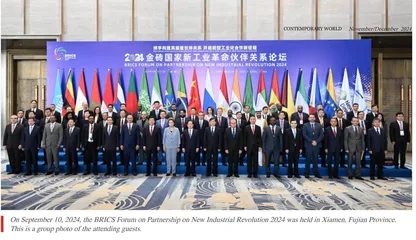Challenges and Responses: Building the Greater BRICS Cooperation Mechanism
作者: Lu Jing

As a distinctive feature of the great transformation across the world, the collective rise of the Global South represented by BRICS countries is making global governance and the world order more just and equitable. The BRICS cooperation mechanism is an important platform for strategic communication and development cooperation among Global South countries. The historic enlargement of BRICS at the beginning of 2024 was a significant milestone in its development history, which has further enhanced the representation of BRICS countries in the Global South and injected new impetus into the cooperation and development of the Global South. However, against the backdrop of the accelerating global changes, the enlargement of BRICS has been given geopolitical significance by some Western countries, increasing the external pressure on BRICS cooperation. Moreover, with the more diverse membership, more intricate interest relations, and the continuous expansion of cooperation areas and scopes after the enlargement, the BRICS cooperation mechanism is facing some new challenges. It is therefore imperative for BRICS countries to respond actively and jointly foster a new dynamic for the high-quality development of the greater BRICS.
The Process and Characteristics of the Development of the BRICS Cooperation Mechanism
Since its inception, BRICS has always attached great importance to building and improving the cooperation mechanism. Now, an institutional system has already been put in place, which takes the BRICS summit as the core and consists of ministerial meetings in various fields such as foreign affairs, finance, economy and trade, industry, agriculture, environment, culture and education, and health, as well as their subordinate specific working group meetings, and forums that involve people from various social sectors such as the Business Forum and the Think Tank Forum. The BRICS cooperation mechanism has not only enhanced the resilience of cooperation among BRICS countries, but also improved their ability to participate in global governance.
I. The Evolution of the BRICS Cooperation Mechanism
The development of the BRICS cooperation mechanism has roughly experienced four landmark transformations.
First, the transformation from a business investment term to a substantive international cooperation mechanism. In 2001, Goldman Sachs first coined the term “BRICs”, which attracted great attention from the international community. In 2006, foreign ministers of Brazil, Russia, India, and China held their first meeting on the sidelines of the United Nations General Assembly, officially launching the BRICS cooperation process. In 2008, the outbreak of the international financial crisis gave birth to the BRICS summit. In support of the summit, BRICS countries established a series of ministerial meeting mechanisms such as the meeting of senior representatives for security affairs, the meeting of foreign ministers at the United Nations General Assembly, the informal meeting of envoys of permanent multilateral institutions, and the meeting of finance ministers and central bank governors. Meanwhile, BRICS countries also put in place various cooperation mechanisms in many fields such as finance, business, agriculture, science and technology, education, think tanks, sister cities, and media. In 2011, South Africa’s accession marked the first enlargement of BRICs, making it officially BRICS.
Second, the institutionalization of the BRICS cooperation mechanism. At the BRICS Summit in Durban in 2013, it was decided to establish the New Development Bank and the Contingent Reserve Arrangement. In 2014, the leaders of the five countries signed the agreements on the establishment of the New Development Bank and the Contingent Reserve Arrangement. In 2015, the New Development Bank officially opened in Shanghai, China, marking the institutionalized operation of the BRICS cooperation mechanism.
Third, the transformation from two pillars to three main drivers. In the early stage of the BRICS cooperation mechanism, while giving priority to cooperation in the financial and economic fields, it also attached importance to cooperation in the political and security fields, highlighting the advancement of two pillars of economy and politics. By the BRICS Summit in Xiamen in 2017, with the facilitation of China, the people-to-people and cultural exchanges among BRICS countries became institutionalized. BRICS cooperation has thus shifted from the traditional two pillars of economy and politics to three main drivers of political and security cooperation, economic and financial cooperation and cultural and people-to-people exchanges, making the BRICS cooperation architecture more comprehensive and balanced.
Fourth, with the transformation from “BRICS Plus” to the historic enlargement of the BRICS, it has embraced a new era of greater BRICS cooperation. In order to strengthen the ties with emerging markets and a large number of developing countries, BRICS has added dialogues between the leaders of the five countries and those of countries and relevant regional organizations in the host country’s region since the Durban Summit in 2013. At the BRICS Summit in Xiamen in 2017, the “BRICS Plus” cooperation model was creatively proposed. However, more countries hoped to become formal members of BRICS. When China served as the rotating chair of BRICS in 2022, it called on the BRICS countries to admit new members, and all parties unanimously agreed to take the BRICS China Year as the opportunity to start the enlargement process. At the BRICS Summit in Johannesburg in 2023, it was announced that new members would be welcomed. At the beginning of 2024, Saudi Arabia, Egypt, the United Arab Emirates, Iran and Ethiopia became formal members of the BRICS, ushering in a new era of greater BRICS cooperation.
II. The Basic Characteristics of the BRICS Cooperation Mechanism